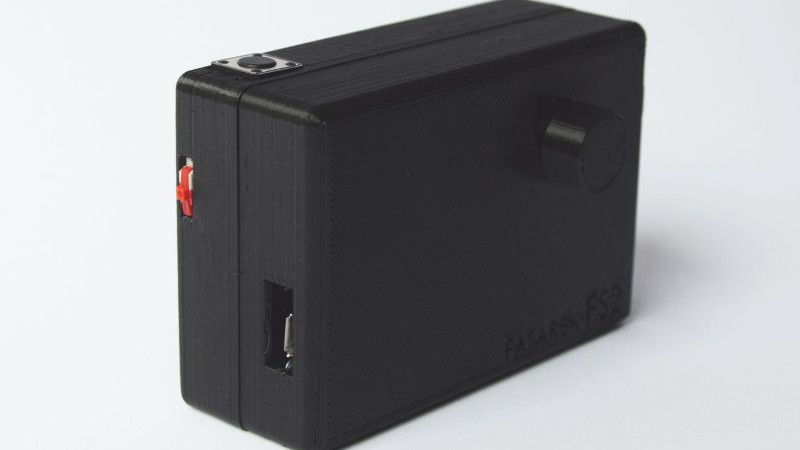If a camera that combines the immediate gratification of a Polaroid with cloud hosting sounds like something that tickles your fancy, look no farther than this ESP-powered point and shoot camera created by [Martin Fasani]. There’s no screen or complicated configuration on this camera; just press the button and the raw picture pops up on the online gallery. Somehow it’s simultaneously one of the most simplistic and complex implementations of the classic “instant camera” concept, and we love it.
 The electronics in the camera itself, which [Martin] calls the FS2, is quite simple. At the core, it’s nothing more than the ESP board, an ArduCAM camera module, and a momentary button for the shutter. To make it portable he added a 2000 mAh Li-ion battery and an Adafruit Micro Micro USB charger. [Martin] added support for an optional 128×64 OLED display for user feedback. Everything is housed in a relatively spacious 3D printed enclosure, leaving some room for possible future hardware.
The electronics in the camera itself, which [Martin] calls the FS2, is quite simple. At the core, it’s nothing more than the ESP board, an ArduCAM camera module, and a momentary button for the shutter. To make it portable he added a 2000 mAh Li-ion battery and an Adafruit Micro Micro USB charger. [Martin] added support for an optional 128×64 OLED display for user feedback. Everything is housed in a relatively spacious 3D printed enclosure, leaving some room for possible future hardware.
There are firmware versions for both the ESP8266 and ESP32, so fans of either generation of the popular microcontroller are invited to the party. Processing images is obviously a bit faster if you go with the more powerful 32-bit chip, but on the flip side the ESP8266 uses 3MB of SPI flash as a local buffer for the images during upload, which helps prevent lost images if there’s a problem pushing them to the cloud. The camera is intended to be as simple as possible so right now the only option other than taking still images is a time-lapse mode. [Martin] hopes to implement some additional filters and effects in the future. He’s also hoping others might lend a hand with his firmware. He’s specifically looking for assistance getting autofocus working and implementing more robust error correction for image uploads.
We’ve seen some impressive DIY camera builds using everything from a salvaged thermal sensor to film and molten aluminum. But the quaint simplicity of what [Martin] has put together here really puts his project in a whole new category.
















This is neat, i was hoping to implement something similar into a weather station for use with wunderground.
I was working on a project to use with wunderground but then the weather channel bought them out and shut down the free API, waiting to see what else changes now and looking for alternatives, hopefully they keep the independent stations going.
I haven’t been following too closely since I shut down my own PWS some time ago (simply because the sensor failed and I never rebuilt it), but it sounded like the changes weren’t too bad for individuals. You could still push data into the system with your own personal station, and in return you’d have access to a free API to receive forecast data back. It seemed like the goal was really to shut down third party apps or sites from using Weather Underground’s forecasts.
More to the point, I always figured that anyone running a PWS was probably using the official Weather Underground site/app to get their forecasts anyway, rather than pulling them down with an API. Is that not the case for what you had planned?
I was working on a simple android app that would display the personalized smart forecast and the ten day forecast only so it was more de-cluttered and maybe do a widget for it that would do an hourly or on demand update. no plans to distribute it or anything so the free API terms would have been good, I’ll have to look into the terms more I guess.
https://github.com/sgjava/weather is a simple ESP8622 weather station with local and outside weather using openweathermaps free apis. I’ve added a second display to get more infomation displayed. I’ll update my github once that is complete. It required a custom NodeMCU build, but the required patches should be in place in Dec. I think. See https://github.com/nodemcu/nodemcu-firmware/issues/2535